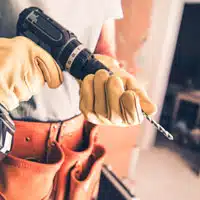Construction workers rely on their tools – yet these devices are often the cause of serious accidents. According to Occupational Safety and Health Administration (OSHA) and Bureau of Labor Statistics (BLS) surveys, close to 400,000 yearly emergency room visits are caused by power tools and other work tools.
Powered hand tools like drills come in many sizes and forms, including power drills, cordless drills, and drill presses. Drill presses are set on fixed stands and are also called drill machines.
There are safety recommendations for all of these, and adhering to them is essential for preventing workplace disasters.
Getting Started Safely
As with any tool, taking time to prepare is the first step. The Canadian Center for Occupational Health and Safety suggests that workers wear personal protective equipment (PPE) like goggles, proper footwear, and gloves.
Drill bits should be kept sharp; if old or bent, they should be swapped out for a new one. When changing out a bit, the power supply should be disconnected.
The drilling area should also be primed. There should not be cords in the drilling area, and items being drilled should be stable and secure. Workers should be standing on level surfaces, in areas that are not muddy or wet.
Additional precautions include never trying to loosen a stuck bit by repeatedly stopping and starting the drill and keeping the drill’s vents clean.
Preventing Electrocution
Electrocution can be a significant risk for workers that use power drills, and safety rules focus on the electrical cords. These should be checked regularly for frayed insulation, splices, and bare wires. Cords should not be pulled on to disconnect them; they should be disconnected from the plug.
In addition, power tools should never be carried by their cords, and cords should be kept from sharp edges, water, oil, and high temperatures. While some electric tools are approved for use in wet locations, this should be properly vetted.
Power Drilling How To’s
Experienced and new workers should be properly trained on power drill usage, and must consistently employ safety measures when working. All employees, including supervisors, should keep safety at the forefront when work is underway.
If using a new or unfamiliar drill, the employee should try it out for a while until they are familiar with it; if it is old or in poor condition, another one should be used.
Drill bits should be chosen carefully, since different jobs require different bits. They should be placed straight into the drill’s jaws and tested to see if they turn smoothly. The pressure used to drill, and the types of bits chosen, both depend on the hardness of the material. Once drilling starts, it should be done slowly and carefully, at a right angle.
Certain materials like Plexiglas can be harder to drill. When an employee is having difficulties drilling through material, they should speak with a manager before proceeding.
In addition, drills may require cutting fluid, which should be chosen carefully before being used.
Milford Work Accident Lawyers at Rhoades & Morrow Represent Workers Injured by Power Drills
Powered drills can cause serious injuries. If you are the victim of a workplace power drill injury, we can help. Contact the experienced Milford work accident lawyers at Rhoades & Morrow, and we will fight to get you the compensation you deserve. We serve clients in Elsmere, Seaford, and across Delaware. Fill out an online contact form or call our Milford office at (302) 422-6705, our Bear office at (302) 600-1107, or our Wilmington office at (302) 427-9500.





